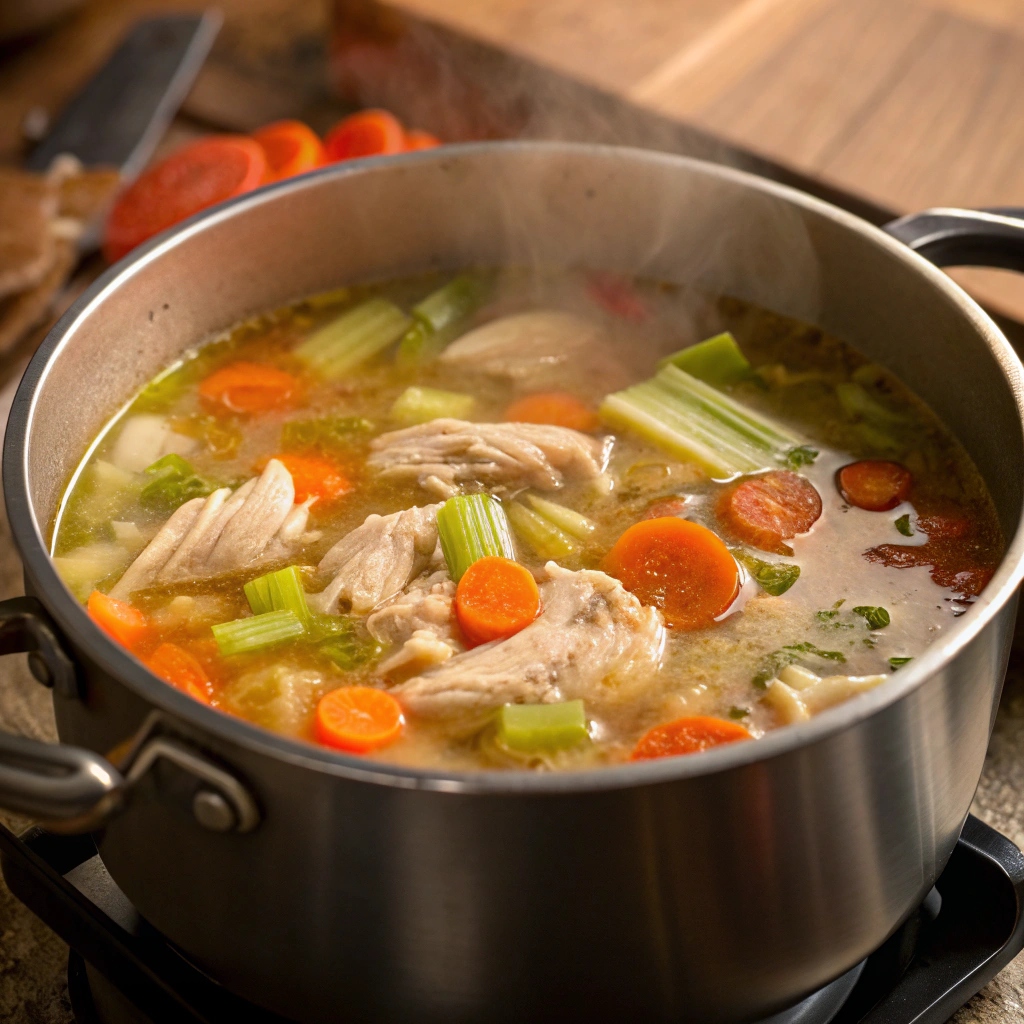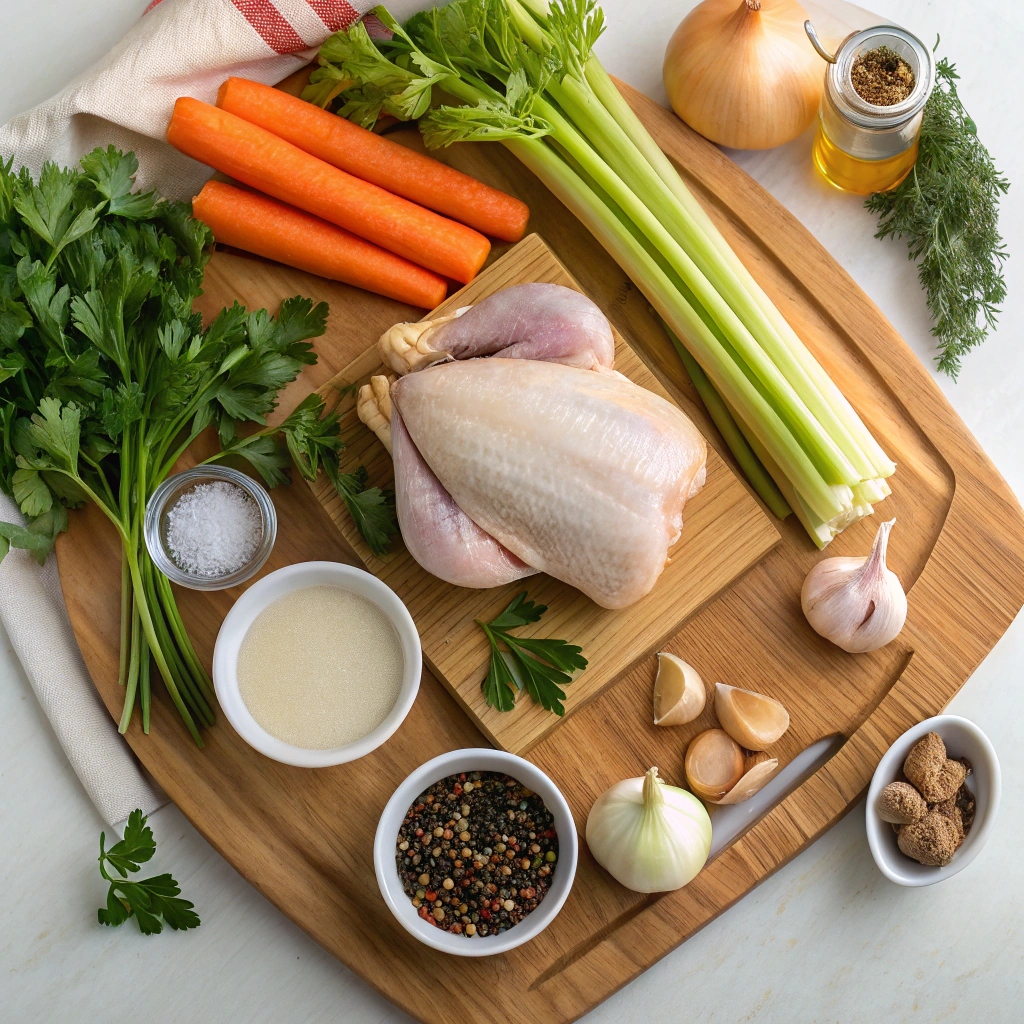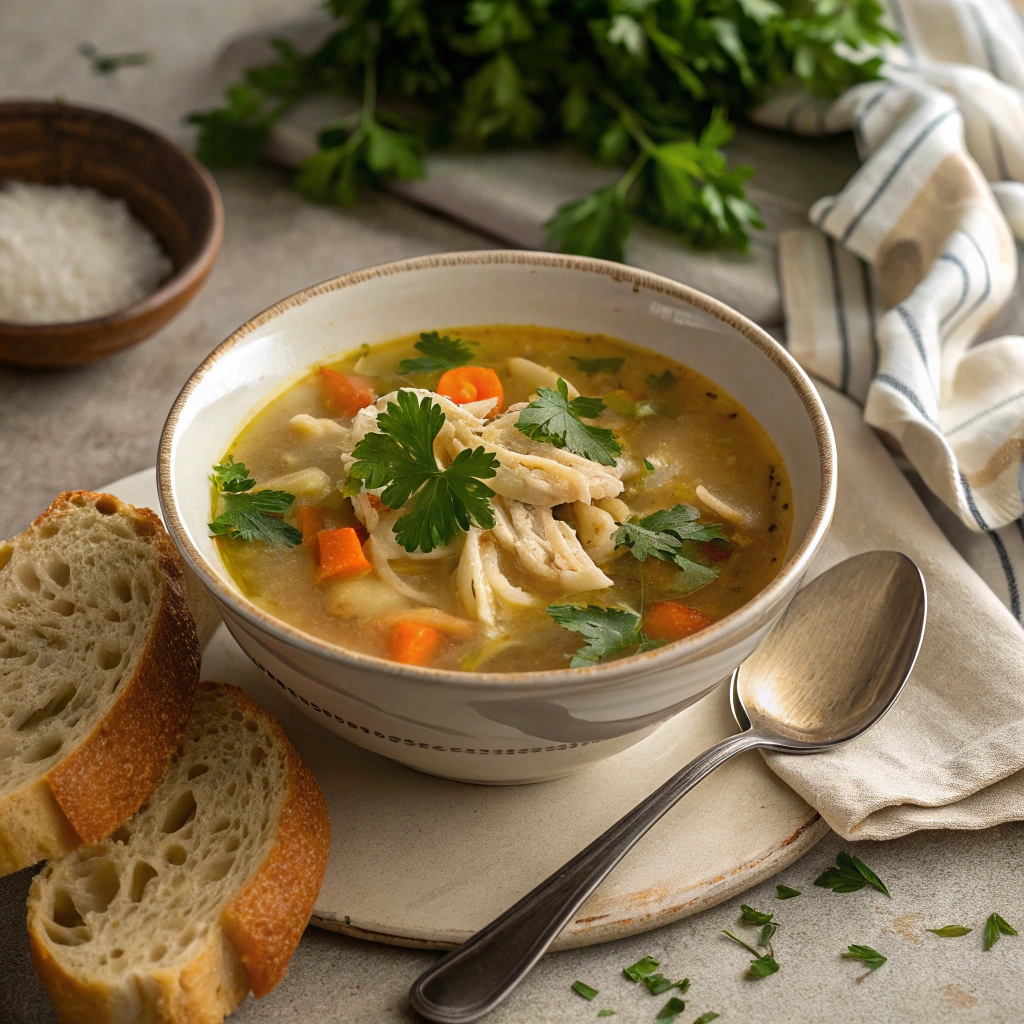Ah, chicken soup! It’s the ultimate comfort food, right? How do I get more flavor in my chicken soup? But let’s face it—sometimes, it falls flat and tastes more like seasoned water than the rich, savory delight we crave. If you’ve ever wondered how to get more flavor in your chicken soup, you’re not alone. The good news is, you’re just a few tips and tweaks away from turning your soup into a masterpiece. Let’s dive into the secrets of making a soup that warms the soul and excites the taste buds! 🥣
Table of contents
Common Problems with Chicken Soup Flavor
1. It Tastes Bland
Ever had chicken soup that tastes like, well, nothing? This happens when the broth lacks depth and seasoning.
2. It’s Too Salty
Salt is essential, but too much of it can overpower all the other flavors. Balancing is key!
3. It’s Too Watery
Thin, watery soup is a major flavor killer. Without proper body, the soup feels incomplete.
Solutions to Elevate Your Chicken Soup
1. Use Quality Ingredients
Great soup starts with great ingredients. Opt for fresh, high-quality chicken, vegetables, and herbs. Organic options can make a noticeable difference!
2. Build Layers of Flavor
Think of your soup as a symphony—each ingredient plays a part. Start by sautéing onions, garlic, and celery in a little olive oil or butter. This caramelization step adds a ton of flavor.
3. Roast the Chicken First
Roasting the chicken before adding it to the pot enhances its flavor. The golden brown bits from roasting create a rich, savory profile in the soup.
“Roasting isn’t just for special occasions. It’s the secret to a soup so flavorful, you’ll wonder why you didn’t try it sooner!”
4. Simmer Low and Slow
Patience is your best friend here. A long, gentle simmer allows the flavors to develop and meld together. Don’t rush it!
Key Ingredients for a Flavorful Chicken Soup
| Ingredient | Quantity |
|---|---|
| Chicken (bone-in, skin-on) | 1 whole or 4-6 pieces |
| Carrots | 2-3, sliced |
| Celery | 2 stalks, diced |
| Onion | 1 large, chopped |
| Garlic | 3 cloves, minced |
| Herbs (parsley, thyme, bay leaf) | Handful |
| Salt and pepper | To taste |

Pro Tips to Boost Chicken Soup Flavor
1. Use Homemade Stock
Store-bought chicken broth is convenient, but it’s often loaded with sodium and lacks depth. Making your own stock is a game-changer. Simmer chicken bones with aromatics like onions, carrots, celery, and herbs for a few hours. The result? Liquid gold that forms the perfect base for your soup.
“Homemade stock isn’t just better; it’s the soul of a great chicken soup!”
2. Add a Parmesan Rind
Want an umami boost? Toss a parmesan rind into the pot while your soup simmers. It infuses the broth with a subtle, cheesy depth that’s irresistible.
3. Incorporate Acid
Acidic ingredients like lemon juice, a splash of vinegar, or even a few diced tomatoes brighten up the flavors and balance the richness. Don’t skip this step—it’s like turning the lights on in your soup!
4. Use Fresh Herbs at the End
While dried herbs are great for simmering, fresh herbs like parsley, dill, or cilantro should be added just before serving. They provide a burst of freshness that elevates the soup.
5. Enhance with Umami-Rich Ingredients
Umami is the “fifth taste” that adds savory depth. Ingredients like soy sauce, miso paste, or a touch of fish sauce can take your chicken soup to the next level. Use sparingly and taste as you go!
6. Thicken the Broth (If Needed)
If your soup feels too thin, you can thicken it by blending a portion of the soup and mixing it back in. Alternatively, adding a handful of uncooked rice or small pasta shapes will naturally thicken the broth as they cook.
Creative Additions to Transform Your Chicken Soup
1. Add Vegetables with Personality
Aside from the classics (carrots, celery, onions), consider adding leeks, parsnips, or even fennel for a unique flavor twist. Roasting the vegetables beforehand can also add a smoky depth.
2. Experiment with Spices
Spices like turmeric, paprika, or a pinch of cumin can introduce a warm, earthy complexity. Don’t be afraid to get creative and cater to your taste preferences!
3. Use Whole Grains
Swap out noodles or rice for hearty grains like barley, farro, or quinoa. Not only do they add texture, but they also make your soup more filling and nutritious.
4. Garnish for Visual Appeal and Taste
Sometimes, it’s the finishing touches that make all the difference. Top your soup with freshly grated parmesan, a drizzle of olive oil, or crunchy croutons. Even a sprinkle of red chili flakes can add a pop of flavor and heat.
Nutrition Facts: Is Chicken Soup Healthy?
Chicken soup isn’t just delicious—it’s packed with nutrients that can support your health. Here’s a quick breakdown:
| Nutrient | Benefit |
|---|---|
| Protein | Helps repair tissues and build muscles. |
| Vitamins A and C | Boosts immunity and supports skin health. |
| Collagen | Promotes healthy skin, hair, and joints. |
| Hydration | Replenishes lost fluids and keeps you energized. |
| Electrolytes | Restores balance and prevents dehydration. |
Whether you’re nursing a cold or just looking for a comforting meal, chicken soup offers both flavor and nourishment. 🍵
Step-by-Step Guide to Making a Flavorful Chicken Soup
1. Prepare Your Ingredients
Start by gathering all your ingredients. This includes chicken (preferably bone-in for maximum flavor), fresh vegetables, aromatics like garlic and onions, and a mix of fresh and dried herbs. Having everything ready before you start cooking makes the process smoother and more enjoyable.
2. Sauté the Aromatics
In a large pot, heat some olive oil or butter over medium heat. Add chopped onions, minced garlic, and diced celery. Cook them until they become soft and fragrant. This step builds the foundation of flavor for your soup.
3. Add the Chicken
Place your chicken pieces in the pot, skin-side down if applicable. Sear them lightly to develop a golden crust, which adds both flavor and color to your soup.
4. Pour in the Water or Broth
Now, add water or chicken stock to the pot. If you’re using homemade stock, even better! Make sure the liquid covers the chicken completely. Bring it to a boil, then reduce the heat to a gentle simmer.
5. Skim the Scum
As the soup simmers, you may notice foam or scum forming on the surface. Skim it off with a spoon to ensure a clear and clean-tasting broth.
6. Add Vegetables and Herbs
Once the chicken has simmered for about 30 minutes, add your vegetables—carrots, celery, and parsnips, for example. Toss in herbs like thyme, parsley, and a bay leaf. These additions will infuse your soup with layers of flavor.
7. Simmer Slowly
Let the soup simmer on low heat for at least an hour. The longer it cooks, the more the flavors will develop. Stir occasionally and adjust the seasoning as needed.
8. Shred the Chicken
Once the chicken is cooked through, remove it from the pot and let it cool slightly. Shred the meat using two forks and discard the bones and skin. Return the shredded chicken to the pot.
9. Adjust the Seasoning
Now’s the time to taste your soup. Add salt, pepper, and a splash of lemon juice or vinegar to brighten the flavors. Remember, a well-seasoned soup is the secret to a satisfying meal.

Optional Additions to Customize Your Soup
1. Noodles or Rice
Adding noodles, rice, or even dumplings can make your soup more filling. Cook them separately and add them to individual bowls to prevent them from becoming mushy.
2. Spices for a Kick
If you enjoy a bit of heat, consider adding red chili flakes, cayenne pepper, or a splash of hot sauce. A little spice can transform your chicken soup into something extraordinary.
3. Creamy Twist
For a creamier soup, stir in a splash of heavy cream or coconut milk towards the end of cooking. It adds richness and a velvety texture.
Final Tips for Perfect Chicken Soup
1. Store Properly
Chicken soup stores well in the refrigerator for up to 5 days. Make sure to let it cool completely before transferring it to airtight containers.
2. Freeze for Later
If you’ve made a big batch, freeze portions for future meals. Use freezer-safe containers or resealable bags. Label them with the date to keep track.
3. Reheat Gently
When reheating, warm the soup over low heat to avoid overcooking the chicken or making the vegetables mushy. Add a splash of water or stock if it’s too thick.
Common Mistakes to Avoid When Making Chicken Soup
1. Overcooking the Chicken
Cooking chicken for too long can make it tough and dry, even in soup. Stick to a gentle simmer and remove the chicken as soon as it’s cooked through. Shredding it and adding it back later keeps it moist and flavorful.
2. Skipping the Skimming Step
Leaving foam and impurities on the surface of your broth can result in a cloudy soup with an unpleasant taste. Take a few extra minutes to skim it off during the simmering process.
3. Adding All Ingredients at Once
Different ingredients cook at different rates. Adding everything at the same time can lead to overcooked vegetables or undercooked chicken. Layering ingredients ensures each component is cooked perfectly.
4. Forgetting to Taste and Adjust
Soup flavor evolves as it cooks, so don’t wait until the end to taste. Regularly taste and adjust with salt, pepper, or acid as needed.
5. Using Low-Quality Broth
If you’re not making homemade broth, choose a high-quality store-bought option. Low-quality broths often have artificial flavors and too much sodium, which can ruin your soup.
Why Homemade Chicken Soup is Worth the Effort
There’s something magical about homemade chicken soup. It’s not just about the taste—it’s about the love and care that goes into making it. When you take the time to simmer the broth, carefully choose fresh ingredients, and add personal touches, the result is a meal that nourishes both the body and soul. How do I get more flavor in my chicken soup?🥰
“Homemade chicken soup is like a hug in a bowl—it comforts, heals, and brings people together.”
From curing colds to warming hearts on a chilly day, chicken soup has a special place in every kitchen. And with these tips, you can make a version that’s not only packed with flavor but also uniquely yours. So grab your pot, gather your ingredients, and start creating magic one ladle at a time!

More Ideas
1. Explore the Perfect Side Dishes for Chicken Soup
Pair your rich, savory chicken soup with complementary dishes. Discover exciting ideas in What Can You Eat With Baingan Bharta? Delicious Pairing Secrets. These pairing tips will elevate your soup experience to a gourmet level.
2. Innovative Ways to Use Leftovers
Got leftover chicken or soup? Don’t let it go to waste! Check out Quick Fixes for Dry Leftover Chicken: Recipes You’ll Love for creative ideas that transform leftovers into mouthwatering new dishes.
3. Make It a Complete Meal
Why stop at soup? Add a hearty twist with Chicken Bacon Ranch Pasta Salad: A Perfect Blend of Flavors. It’s a satisfying and easy addition to any dinner table.
4. Discover One-Pan Chicken Wonders
Simplify your cooking with recipes like Chicken Meets Pasta: How to Nail One Pan. These easy one-pan recipes will inspire quick and delicious dinners.
5. The Science Behind Broth
Ever wondered what makes a broth rich and nutritious? Dive into Soup Bones: Recipes and Benefits – The Ultimate Guide to Delicious and Nutritious Broths.
6. Incorporate Fresh Flavors
If you love experimenting, explore Why Do You Soak Eggplant in Water Before Cooking?. Techniques like these can help you incorporate new textures and flavors into your soup.
7. Rotisserie Chicken Hacks
Save time with rotisserie chicken while keeping the flavor intact. Get inspired by Secrets to Making the Best Rotisserie Chicken Pasta.
8. Breakfast Meets Soup
Start your day with warmth! Learn about adding unique breakfast pairings like Jimmy Dean Breakfast Sandwich: Healthy? The Truth About Its Nutrition.
9. Comfort in a Bowl
Turn soup into a heart-winning dish with recipes like Marry Me Chicken Soup Recipe: Irresistible Comfort Food That Wins Hearts.
10. Reinvent Your Broth with Pasta
Explore how soups can integrate pasta for added texture in Irresistible Recipe for Pasta Fazool with Chicken: Comfort in Every Bite.
Conclusion: Master the Art of Chicken Soup
By now, you’ve learned all the tips, tricks, and techniques needed to get more flavor in your chicken soup. From choosing quality ingredients to layering flavors, adjusting seasonings, and avoiding common mistakes, you’re well on your way to making soup that’s truly unforgettable. Remember, cooking is an art, and every pot of soup tells a story—make yours a flavorful one!
Next time someone asks, “How do I get more flavor in my chicken soup?” you’ll be the expert they turn to. So go ahead, experiment, and most importantly, enjoy every spoonful of your delicious creation! 🥣✨
Print
How do I get more flavor in my chicken soup?
- Total Time: 2 hours 20 minutes
Description
This hearty chicken soup is crafted to deliver deep, rich flavors that warm the soul. By utilizing quality ingredients and layering flavors through careful cooking techniques, this recipe ensures a comforting and satisfying experience in every bowl.
Ingredients
1 whole chicken (about 4 pounds), preferably organic
2 tablespoons olive oil
2 large onions, chopped
4 cloves garlic, minced
4 carrots, peeled and sliced
3 celery stalks, diced
2 parsnips, peeled and sliced (optional)
1 teaspoon dried thyme
2 bay leaves
10 cups low-sodium chicken broth or homemade stock
Salt and freshly ground black pepper, to taste
1 tablespoon fresh lemon juice
1/4 cup fresh parsley, chopped
Instructions
Prepare the Chicken: Rinse the chicken under cold water and pat dry. If desired, roast the chicken in a preheated oven at 400°F (200°C) for 30 minutes to enhance flavor.
Sauté Aromatics: In a large stockpot, heat olive oil over medium heat. Add chopped onions and cook until translucent, about 5 minutes. Add minced garlic and cook for an additional minute.
Add Vegetables: Incorporate carrots, celery, and parsnips into the pot. Sauté for 5-7 minutes until they begin to soften.
Season: Stir in dried thyme and bay leaves, allowing them to release their aromas.
Combine with Broth: Place the whole chicken into the pot and pour in the chicken broth. Ensure the chicken is fully submerged; add water if necessary.
Simmer: Bring the mixture to a gentle boil, then reduce heat to low. Cover and let it simmer for 1.5 to 2 hours, or until the chicken is tender and fully cooked.
Skim and Adjust: Periodically skim off any foam or fat that rises to the surface to keep the broth clear.
Remove and Shred Chicken: Carefully remove the chicken from the pot. Once cool enough to handle, discard the skin and bones, and shred the meat into bite-sized pieces. Return the shredded chicken to the pot.
Finalize Seasoning: Stir in fresh lemon juice and chopped parsley. Taste and adjust seasoning with salt and freshly ground black pepper as needed.
Serve: Ladle the hot soup into bowls and enjoy with crusty bread or a side salad.
Notes
Homemade Stock: For an even richer flavor, consider making your own chicken stock by simmering chicken bones with aromatics and herbs prior to preparing the soup.
Umami Boost: Adding a small amount of soy sauce or miso can enhance the savory depth of the broth.
Vegetable Variations: Feel free to add other vegetables like zucchini, spinach, or peas to customize the soup to your liking.
Storage: Store leftovers in an airtight container in the refrigerator for up to 3 days or freeze for up to 3 months. Reheat gently on the stovetop to maintain the integrity of the ingredients.
- Prep Time: 20 minutes
- Cook Time: 2 hours
- Cuisine: American
Nutrition
- Serving Size: 6-8
- Calories: 350
- Sugar: 6g
- Sodium: 800mg
- Fat: 15g
- Saturated Fat: 4g
- Carbohydrates: 20g
- Fiber: 4g
- Protein: 32g
- Cholesterol: 120mg
Keywords: Chicken Soup, Comfort Food, Homemade Soup, Flavorful Chicken Soup, Hearty Soup
